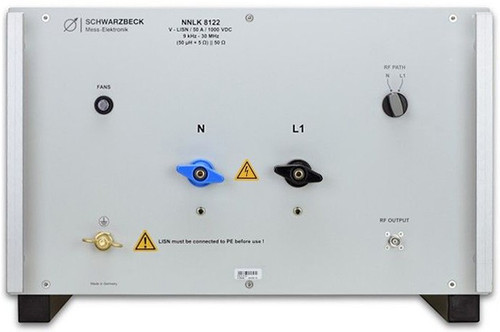Overview
Typical attenuation EuT-terminals to BNC. Individual data is attached to every LISN.
The calibration includes a normalisation of the voltage at the EuT terminals of the LISN with terminated LISN output. Then the insertion loss from the EuT terminals to the BNC terminals of the LISN is being measured.
Typical Impedance at EuT terminals, BNC terminated. Individual data is attached to every LISN.
The impedance at the EuT terminals is determined with the BNC-connector terminated with 50 ?. The use of an appropriate calibration adapter is mandatory to get accurate results.
Instructions for use:
The purpose of a LISN is to provide the device under test with energy, to carry the interference voltage to the EMI measurement receiver and to load the RF emitted by the device under test with a standardized impedance.
Important! Connect the LISN to protecting earth BEFORE applying any voltage to it! For this purpose you can use the greenyellow wing terminals at the front and rear panel and the aluminum brackets at the rear side of the device.
The wing terminals have a diameter of 16 mm and are removable.
Due to high capacities very high leakage currents can occur (above 1 A). Thus it is not possible to use a residual current operated circuit breaker. It is recommended to use an isolating transformer.
The LISN must not be covered by all means to provide good air ventilation. The perforated metal plates must not be covered. To improve the ventilation turn the fans on. The device under test has to be connected to the wing terminals at the front panel. The coaxial RF output has to be connected to the EMI measurement receiver using a BNC coaxial cable.

Schematic circuit diagram of the NNBL 8240
IEC Connector
At the rear panel of the LISN you can find an IEC connector. The voltage can be chosen between 110 and 220 V. Therefore the drawer carrying the fuses has to be removed to be able to put in the yellow selection jumper in the right direction. The IEC connector provides power to the fans which can be turned on with the push button switch at the front panel.
| Schwarzbeck NNBL 8240 Specifications | ||
| Frequency Range | (9) 150 kHz – 100 MHz | |
| Max. cont. current | 800 A | |
| Max. current (limited time) | 1000 A | |
| Max. voltage DC | 1000 V | |
| Max. voltage 50/60 Hz | 650 V | |
| Impedance | (50 µH + 5 Ω) || 50 Ω ±20 % | |
| Resistance of coil | < 3 mΩ | |
| Weight | 45 kg | |
| Connector EuT | Wing terminals, 16 mm, removable | |
| RF output | BNC (optional N) | |
| Dimensions incl. connector width x height x depth |
450 mm x 500 mm x 750 mm | |
| Fuse for fans | 2 A, T | |
| According to standard | MIL-STD-461E | |













